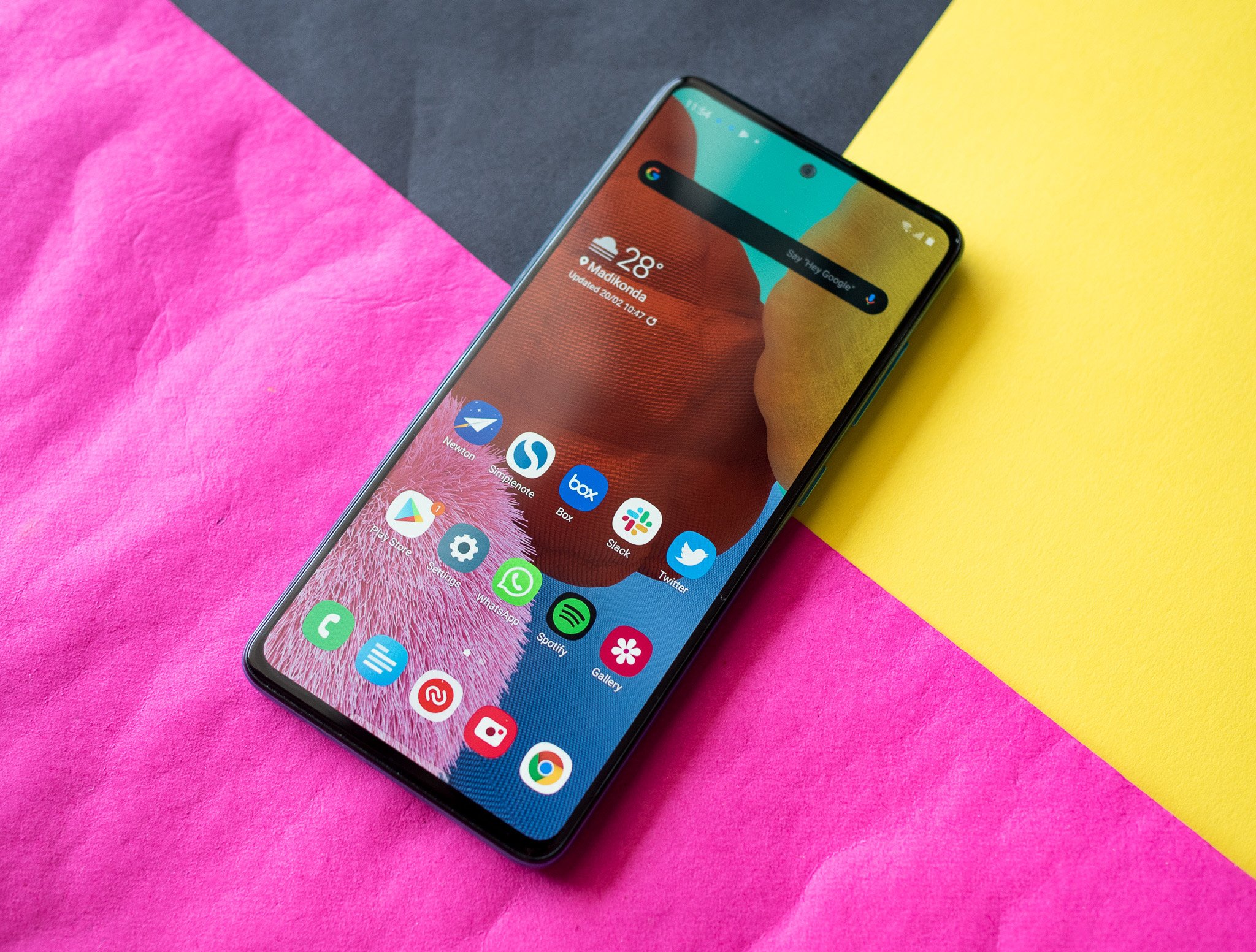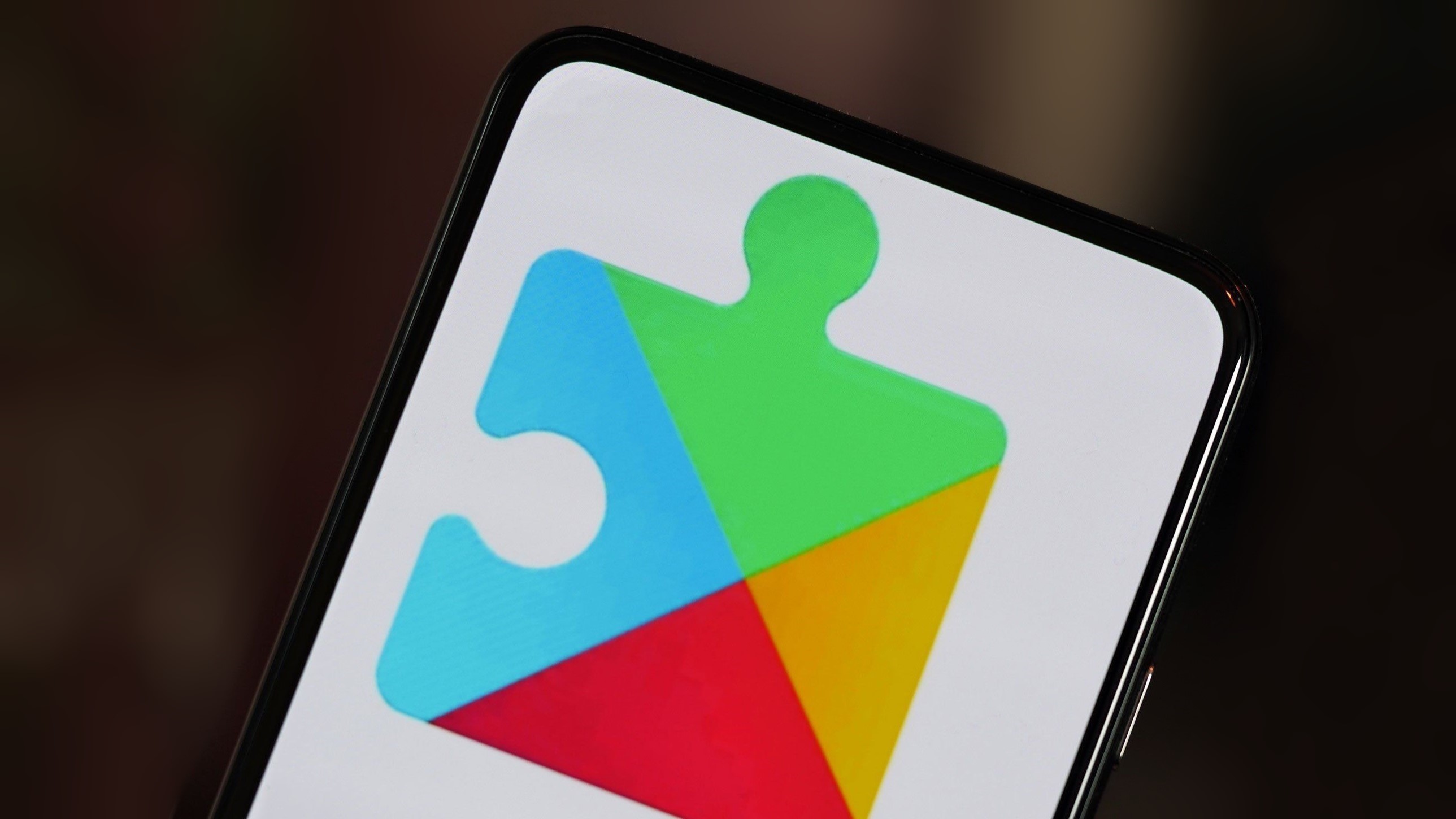Android Central Verdict
Bottom line: The Galaxy A51 shares the same fundamentals as the Galaxy A50 and A50s. The 48MP camera takes decent shots during the day, you get all-day battery life, a vibrant AMOLED display, 3.5mm jack, and Android 10. But the hardware just doesn't hold up anymore, and there are much better alternatives available at the same price point.
Pros
- +
48MP camera
- +
3.5mm jack
- +
Gorgeous new design
- +
Long-lasting battery
- +
One UI 2.0 with Android 10
Cons
- -
Aging hardware
- -
Laggy in daily use
- -
Low-light shots are unusable
- -
Macro lens is limited
Why you can trust Android Central
Under increased pressure from Chinese rivals, Samsung overhauled its budget strategy in 2019. The underwhelming Galaxy J series was gone, and the Galaxy A lineup essentially took its place. Samsung traditionally limited the Galaxy A series to the mid-range segment, but now it fields devices starting as low as $120 all the way to $600.
The new-found change in focus also came with better product releases. The Galaxy A50 was one of the best budget Android phones you could buy in 2019, featuring great hardware, a fresh design, and decent cameras. In typical Samsung fashion, the company introduced an updated model six months down the line in the Galaxy A50s, and at the start of 2020, the Galaxy A51 made its debut.
The Galaxy A51 is a continuation of what Samsung has been doing in this segment for the last two years. There are a few enticing changes — particularly around the camera side of things — but the fundamentals are unchanged from last year. In fact, 80% of what I wrote in my Galaxy A50 review is relevant for the A51, because the underlying hardware hasn't changed much.
That said, the Galaxy A51 isn't a bad phone. If anything, the new design and the fact that it has received the One UI 3.1 update with Android 11 makes it a great option for under $350. Now that the Galaxy A52 and A52 5G are available, let's take a look at where the Galaxy A51 slots into Samsung's portfolio in 2021.
Samsung Galaxy A51 Price and availability
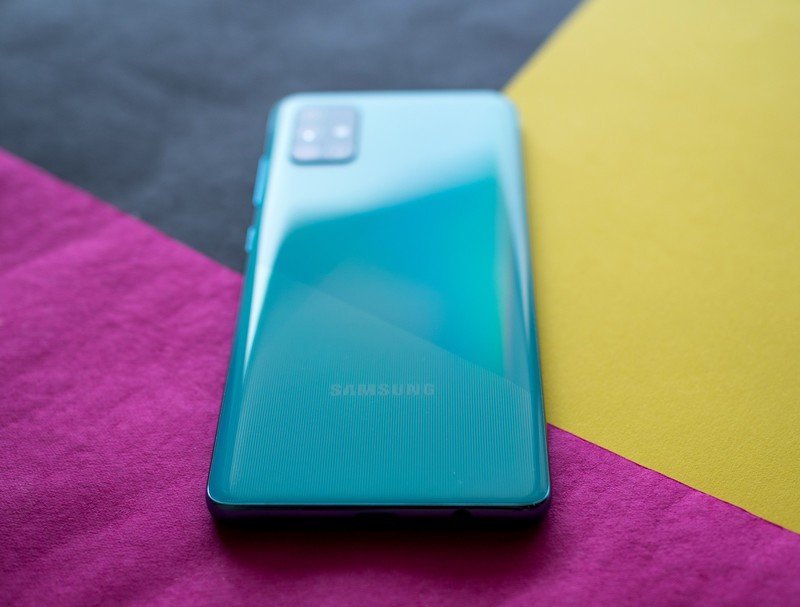
The Galaxy A51 was unveiled on 16 December 2019, and went on sale in global markets starting January 2020. The phone is available in all markets where Samsung has an official presence. The phone is sold in both 4G and 5G versions, and in the U.S., the Galaxy A51 5G is now available for $400.
Over in the UK, the Galaxy A51 5G retails for £329 ($450), and in India, you can get your hands on the 4G version of the A51 for ₹22,499 ($300). The phone is available in four colors: Prism Crush Black, Prism Crush White, Prism Crush Blue, and Prism Crush Pink.
Samsung Galaxy A51 Design and display
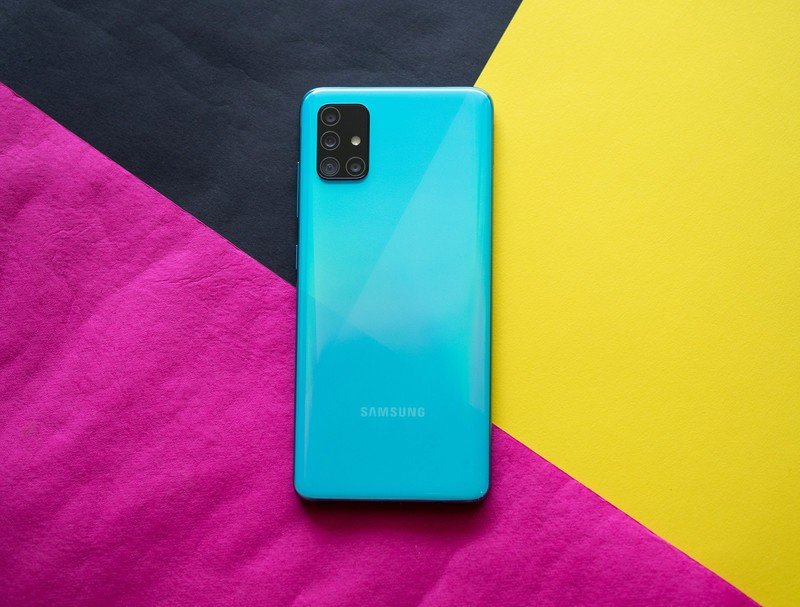
No other brand rolls out iterative updates quite like Samsung, and in the last five years it has managed to turn iteration into an art form. The Galaxy A51 takes a lot of cues from the A50s, which in turn was based on the A50. So essentially, a lot of the internal hardware that you get in the A51 is two years old at this point.
But that doesn't mean there are no new features on the A51. Let's start with the back: the A51 has two diagonal lines across its surface that break up the design — just like the A50s — but this time there's a gradient effect that shows up when light hits the surface. That gradient effect is the basis for the device's colors, with the A51 available in Prism Crush Black, Prism Crush Blue, and Prism Crush White.
With a vibrant design and Infinity-O cutout, the Galaxy A51 continue to look great in 2021.
The lower quadrants also feature subtle lines that further differentiates the design, and the overall effect is that the A51 is one of the best-looking phones Samsung has released to date. I'm using the blue option, and the vibrant color makes the phone stand out. Like the A50, the back is made out of plastic, but the glossy finish gives it a glass-like feel. The best part is that it doesn't smudge as easily as a glass back, and it is more durable.
Another major change at the back is the camera housing. The rectangular camera housing is identical to that of the Galaxy S20 series, and it's clear that Samsung is trying to create a design identity here. While the camera housing is by no means attractive, it is consistent across all of Samsung's 2020 devices.
The major design change at the front is the Infinity-O cutout for the front camera module. The A50 and A50s featured the Infinity-U cutout, and the cutout on the A51 is smaller and better integrated into the design. The bezels are razor-thin this time around, and it makes using the A51 that much more enticing.
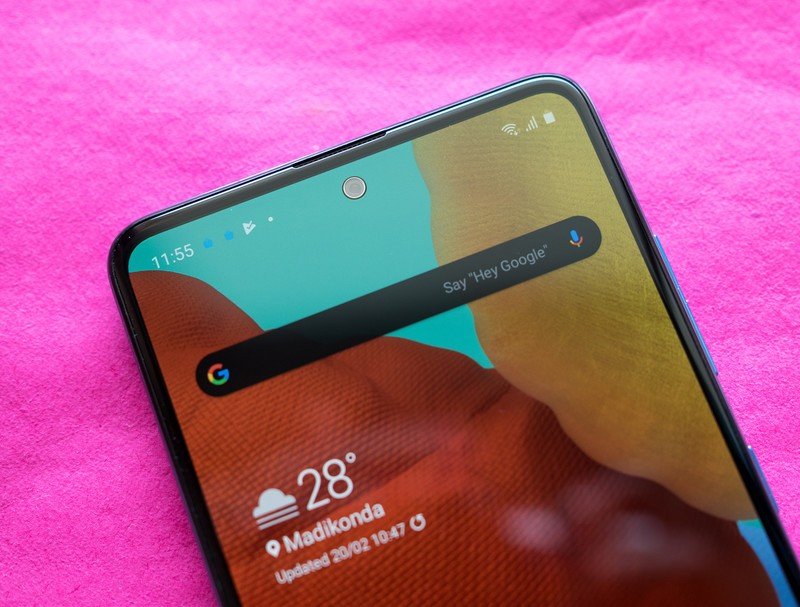
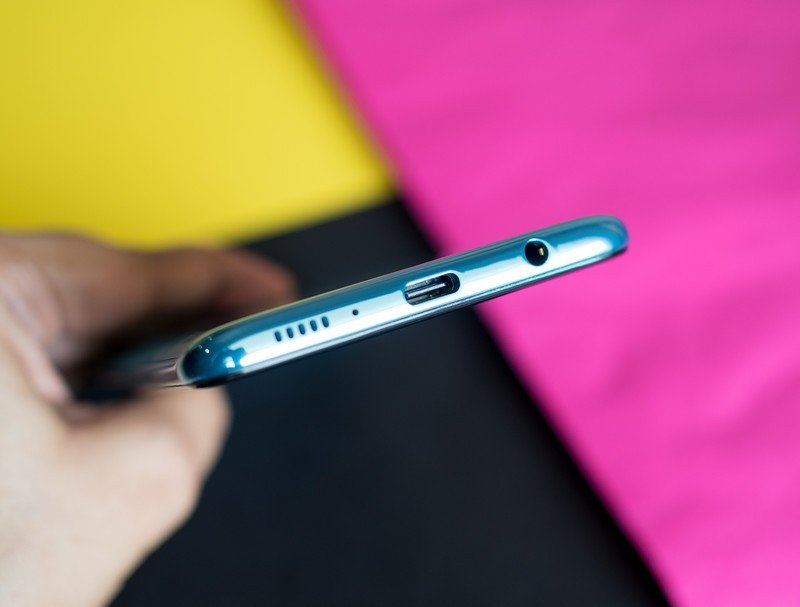
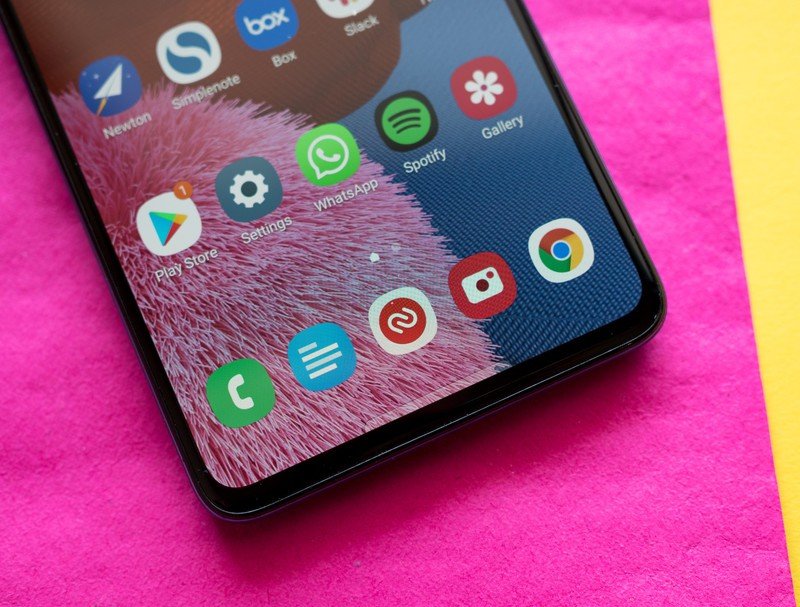
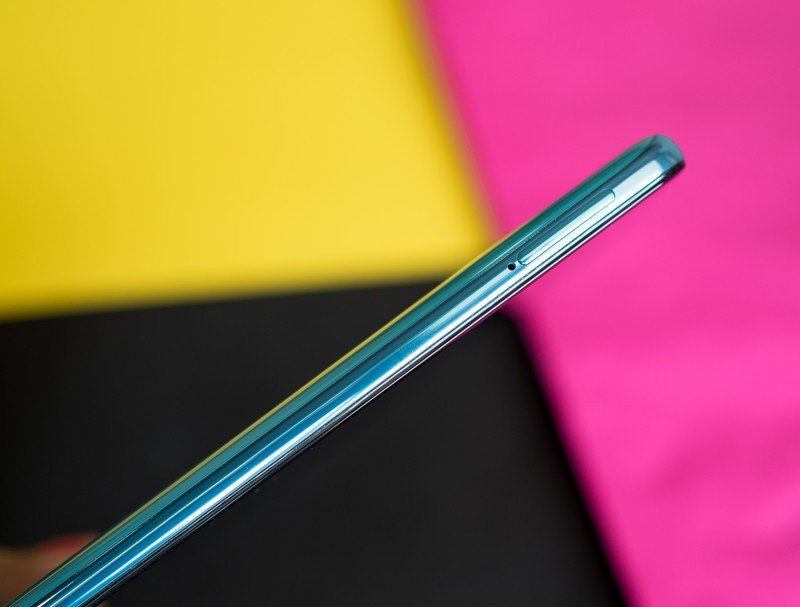
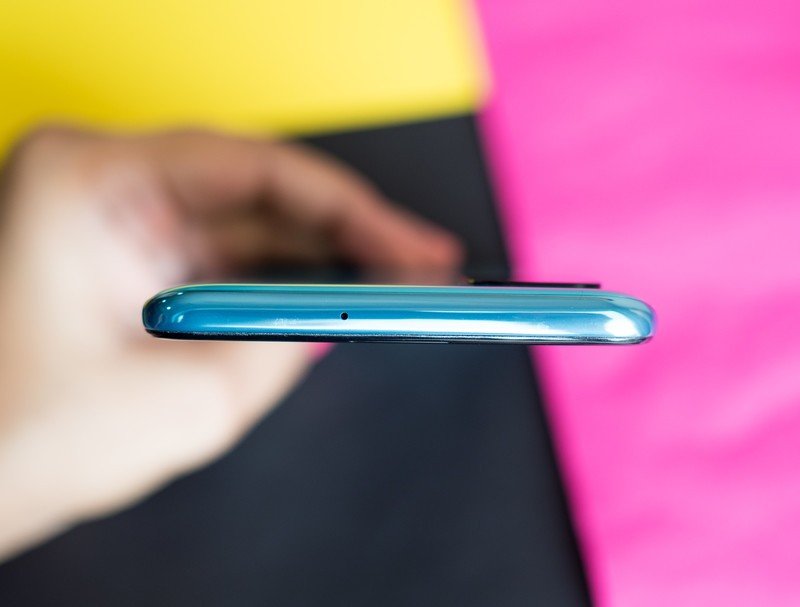
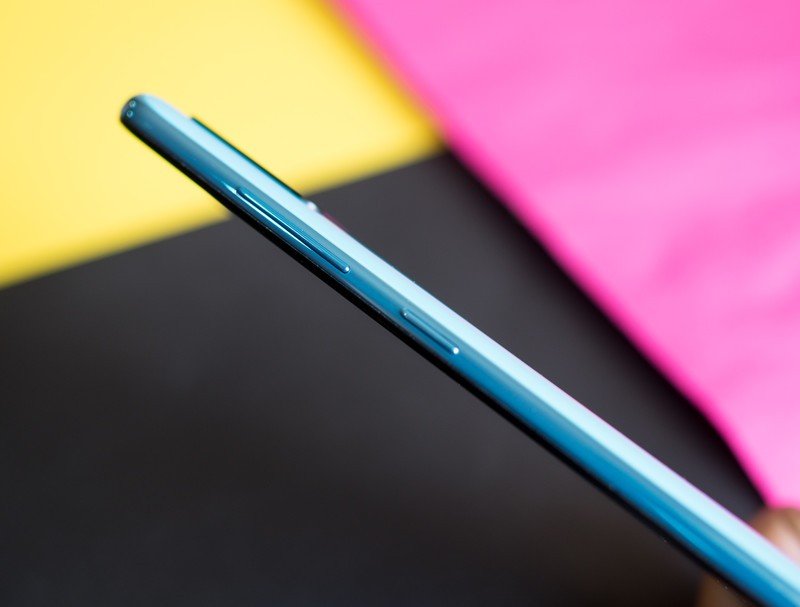
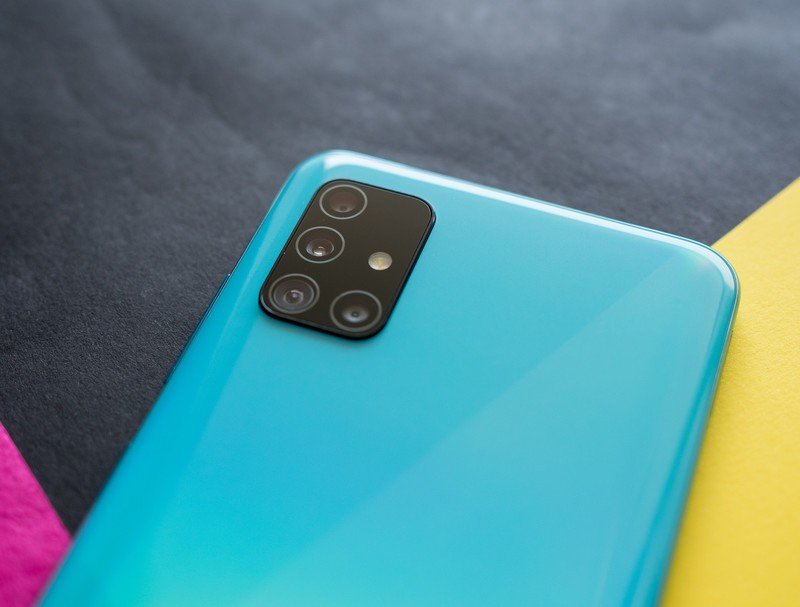

Rounding out the design, you'll find the power and volume buttons on the right, and the 3.5mm jack, USB-C charging port, and a solitary speaker at the bottom. Samsung has also moved away from the 3.5mm jack on its flagships, so it's good to see the analog jack intact on the A51. The SIM card tray is on the left, and you get the option to slot two SIM cards as well as a MicroSD card. Of course, the variant of the A51 sold in global markets has a single SIM slot.
The Galaxy A51 is astonishingly light at 172g for a phone that has a 4000mAh battery, and it has a great in-hand feel thanks to the subtle curves at the back. With a width of 73.6mm, the phone is also narrow, and while it isn't conducive for one-handed usage, it is on the lower end of the scale as far as phone sizes go.
The Galaxy A51 has the same 60Hz AMOLED display as the A50, but that's not a bad thing.
Coming to the screen, the Galaxy A51 has a 6.5-inch Super AMOLED display that ticks all the right boxes. Colors are vibrant, you get decent viewing angles, and there weren't any issues while using the screen under harsh sunlight. You get to choose from Natural or Vivid picture modes, and there's no option to manually tweak the color balance of the screen.
With the Galaxy A52 series introducing high refresh rates, you do miss out in this area on the A51. The A52 has a 90Hz AMOLED, and the A52 5G takes things up a gear and offers a 120Hz AMOLED panel, so the 60Hz panel on the A51 feels rather plain.
But you do a blue light filter that can be customized to run from sunset to sunrise, and you get the other scaling and font sizing options that are standard on all Samsung phones. The screen is protected by a layer of Gorilla Glass 3, another area that's unchanged from the A50. That's true for the panel quality itself — other than the switch to an Infinity-O cutout and a minor 0.1-inch increase in screen size, there isn't any difference from the A50 or A50s. That's not necessarily a bad thing though, as the screen holds up just fine in 2021 — provided you don't need a 90Hz panel.
Samsung Galaxy A51 Hardware and battery
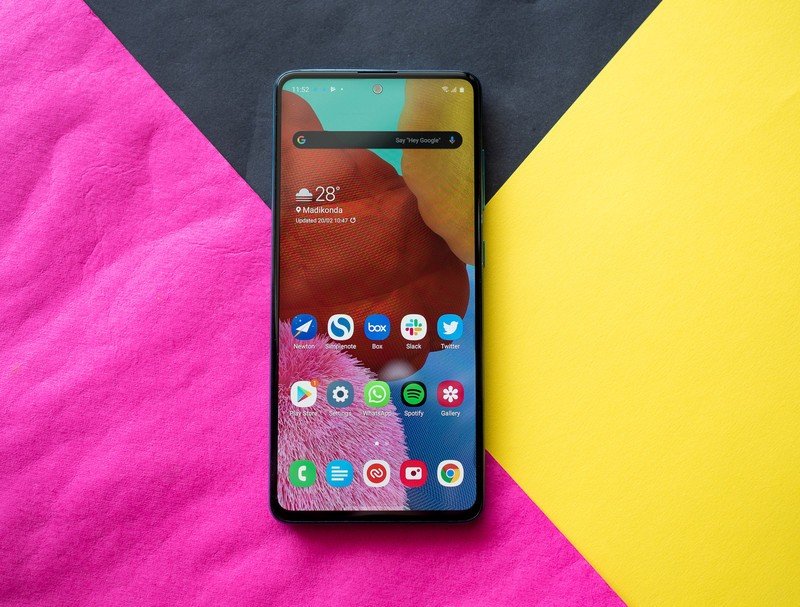
Samsung has been recycling hardware on its phones for several years, and it's no different on the Galaxy A51. The phone is powered by the Exynos 9611, the same as the A50s. The A50 had the Exynos 9610, and while the Exynos 9611 is marketed as a new chipset, the only difference from the 9610 is that it can facilitate 48MP camera modules. Both the 9610 and 9611 use the same set of cores and the same Mali G72 for visuals, and they're both fabricated on a 10nm node.
| Specs | Samsung Galaxy A51 |
|---|---|
| Software | One UI 3.1 based on Android 11 |
| Display | 6.5-inch (2400x1080) Super AMOLED |
| Chipset | 2.30GHz Exynos 9611 |
| RAM | 4GB/6GB/8GB |
| Storage | 64GB/128GB |
| Rear Camera 1 | 48MP ƒ/2.0 (primary) |
| Rear Camera 2 | 12MP ƒ/2.2 (wide-angle) |
| Rear Camera 3 | 5MP ƒ/2.4 (macro) |
| Rear Camera 4 | 5MP ƒ/2.2 (portrait) |
| Front Camera 1 | 32MP ƒ/2.2 |
| Connectivity | Wi-Fi 802.11 ac, BT5.0, NFC |
| Battery | 4000mAh | 15W |
| Security | In-screen fingerprint |
| Colors | Prism Crush Black, Prism Crush White, Prism Crush Blue |
| Dimensions | 158.5 x 73.6 x 7.9mm |
| Weight | 172g |
If anything, Samsung is shortchanging buyers on the storage front, with the A51 offering UFS 2.0 storage whereas the A50 and A50s had UFS 2.1 storage. Let's get back to the hardware, because Samsung's decision to use the Exynos 9611 in the A51 makes things sluggish in day-to-day use. The chipset has four Cortex A73 cores at 2.3GHz and four energy-efficient A53 cores at 1.7GHz, and there's just not enough grunt to handle even basic tasks like web browsing.
You will notice lag at times even while navigating the user interface, with actions like opening the app drawer causing a negligible delay. Then there's the issue of gaming, and the Mali G72 just does not hold up in titles like PUBG and Fortnite. If you're serious about mobile gaming, you're better off picking up the Galaxy A52 instead — it has a Snapdragon 720G and holds up much better. The A51 is barely adequate even for everyday use — you should not be able to see lag when exiting an app to go to the home screen.
The phone is available with 6GB/128GB and 8GB/128GB variants in India, but in other markets Samsung offers the A51 with a 4GB option. There's a MicroSD slot that can accommodate cards up to 512GB in size, and you also get NFC with Samsung Pay, Bluetooth 5.0 LE, FM radio, and Wi-Fi ac. The optical in-display fingerprint sensor is fast and reliable, and I didn't face any issues with it.
On the connectivity front, the A51 has LTE bands 1/2/3/4/5/7/8/12/17/20/26/28/38/40/41/66. That should be more than adequate to connect to most LTE networks around the world, and the phone comes with different LTE bands based on the region.
Yet another area where things are unchanged is battery. The A51 has the same 4000mAh battery with 15W fast charging, and I didn't have any issues with battery longevity. The phone manages to last a day with ease, and although the hardware itself hasn't changed from the A50, I got better battery usage figures on the A51.
Samsung Galaxy A51 Cameras
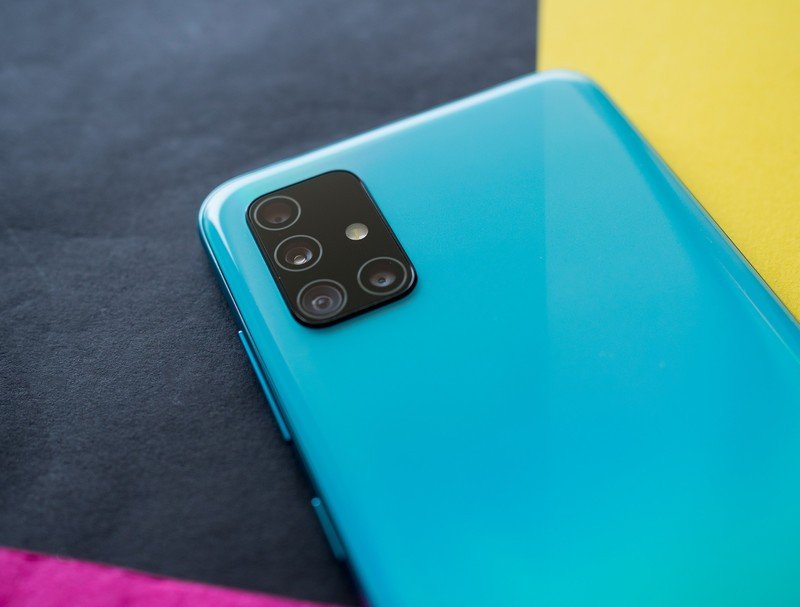
The highlight with the Galaxy A51 is the quad camera array at the back: there's now a 48MP primary camera joined by a 12MP wide-angle lens, 5MP macro shooter, and another 5MP lens for portrait mode. You get a 32MP camera up front, which is a minor upgrade from the 25MP shooter on the A50.
The camera interface itself should be immediately familiar if you've used a Samsung phone recently. The main shooting modes are laid out in a ribbon at the bottom, and you can edit these as needed based on your preferences. There are toggles for flash, timer, filters and beautify effects, and you can easily switch between the primary lens and wide-angle shooter.


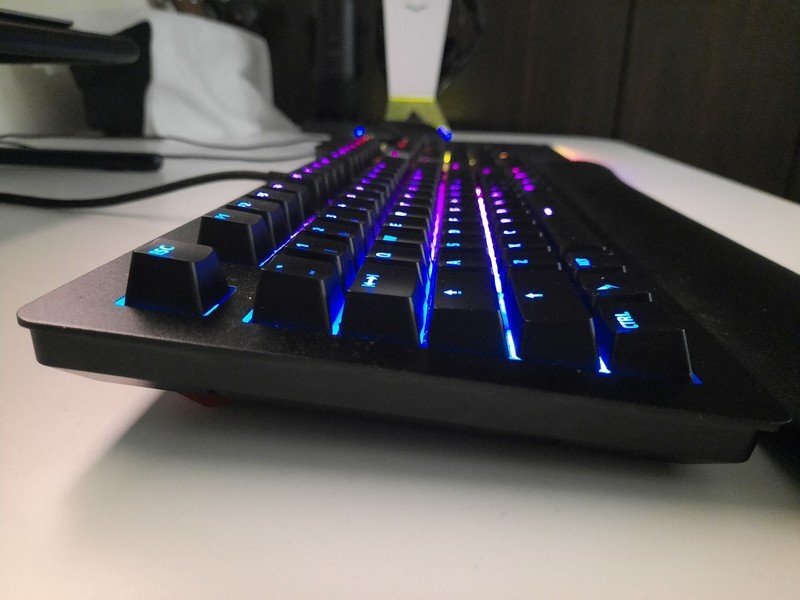

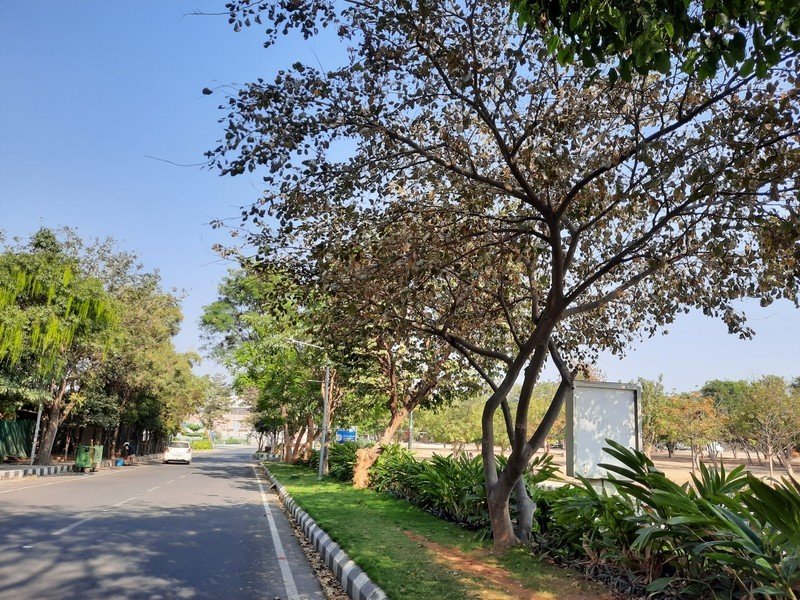
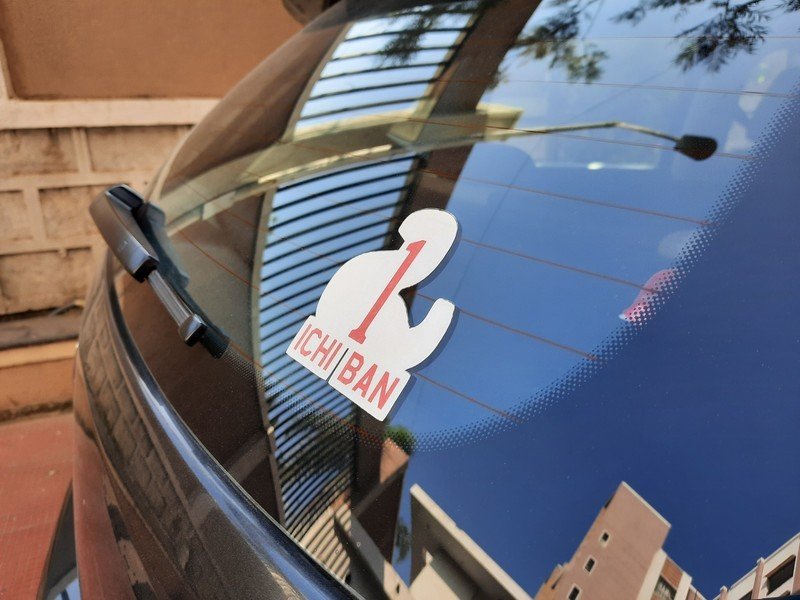



The 48MP camera is a known quantity at this point, and it takes great shots in daylight conditions. Resultant images have plenty of detail and decent dynamic range, and you get those saturated colors that define Samsung's cameras. One of the biggest changes Samsung made is with the ultra-wide lens, with the shooter managing to produce shots with the same level of detail as the primary lens.
As good as the A51 is in daylight conditions, shots in artificial or low lighting are a blotchy mess. There's far too much noise, colors are washed out, and the final images are just nowhere near good enough for sharing on social platforms.
The macro lens does not have autofocus, and it struggles to dial in on busy subjects, like a watch face. Regardless of what I tried, I could not get it to focus on the watch face of my Promaster Skyhawk, and although the 5MP resolution is higher than what you get with most other phones, the macro lens is still very limited in its usability.
Samsung Galaxy A51 Software
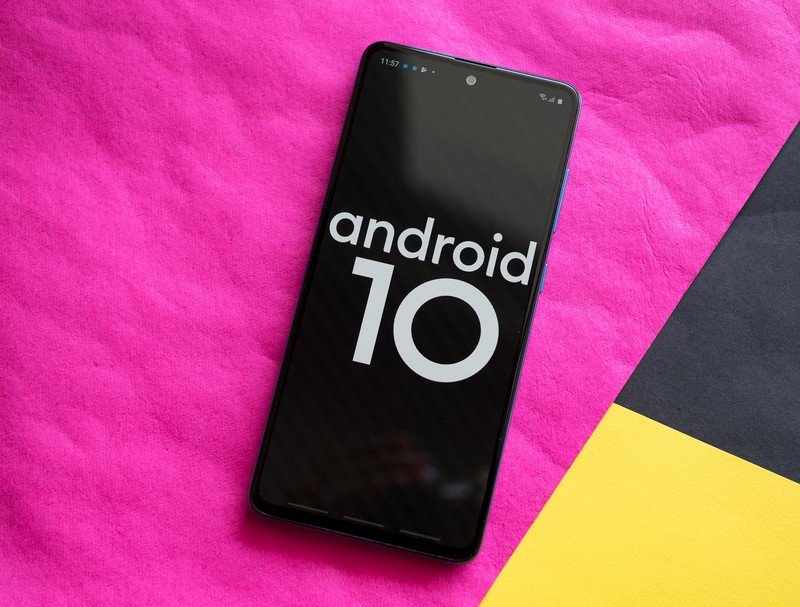
The Galaxy A51 launched with One UI 2.0 based on Android 10 out of the box, and the phone picked up the Android 11 update and is now running One UI 3.1. Samsung is doing a much better job in terms of software updates, and the A51 made the switch to the latest version of Android back in January 2021.
The Galaxy A51 is running One UI 3.1 based on Android 11, and it will get three updates.
Samsung offers plenty of features with One UI 3.1, and the Galaxy A51 looks and feels the same in terms of the UI when seen against the Galaxy S21 series.
Samsung's gestures include designated zones at the bottom of the screen from where you swipe up. It is an elegant solution, and is easier to get acclimated to if you're switching from the legacy navigation keys. But the fact that you also get Android 11's gestures — with the swipe-in from either side to go back, and swipe up from the bottom of the screen to go to the home screen — makes it that much more enticing.
You also get Edge screen, with the ability to configure pull-out Edge panels and set up Edge lighting for incoming notifications and calls. Edge lighting makes up for the fact that phones these days don't have an LED notification light, and there's just a lot of customizability to choose from here.
The A51 has software-based face unlock, and while it isn't as secure as a fingerprint reader, it is fast. Elsewhere, you get the ability to use two instances of an app at once, Bixby, off-screen gestures, Digital Wellbeing controls, and one-handed mode. Samsung made a dedicated effort to modernize its UI in recent years, and One UI 3.1 is a continuation of these efforts.
Samsung Galaxy A51 The competition
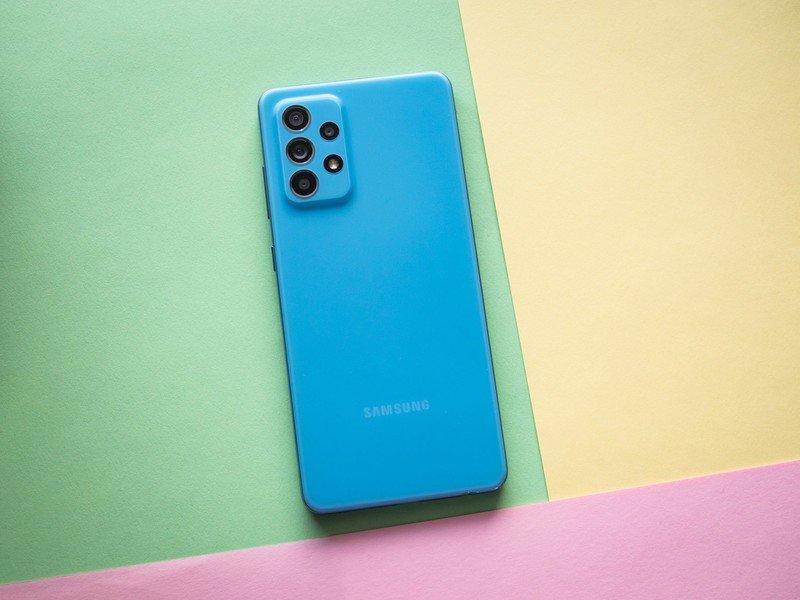
If you're looking to pick up a new phone in 2021, the Galaxy A52 5G is the obvious choice. The phone has a fresh new design, upgraded internals, and a 120Hz AMOLED panel that is sublime. The phone is available for $500, making it a great overall option if you want a 5G-enabled phone that doesn't cost too much money.
Of course, if you're not interested in switching to 5G just yet, the Pixel 4a continues to be a reliable choice in this category. For $350, you get a phone with a standout camera, clean software without any bloatware, regular updates, and all-day battery life.
Samsung Galaxy A51 Should you buy it?
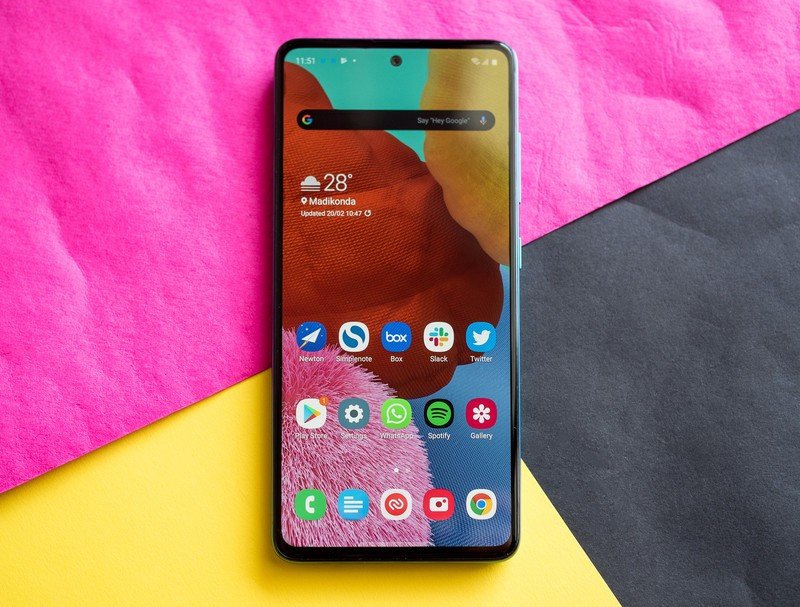
You should buy this if ...
- You want a large vibrant display
- You're looking for a reliable budget phone
- You want decent cameras
- You need a phone with great battery life
You shouldn't buy this if...
- You want the latest hardware
- You need a 90Hz or 120Hz AMOLED screen
- You're looking to switch to 5G
The Galaxy A51 isn't vastly different from what Samsung offered in this segment in 2019, but the upgrades to the camera and design allow it to stand out. The 48MP camera takes decent shots during the day, the display is one of the best you'll find in this segment, the battery life is fantastic, and you get the latest One UI 3.1.
3.5 out of 5
That said, the hardware is slow compared to the rest of the field, and you will see noticeable lag in day-to-day use. Also, it doesn't make sense to buy the Galaxy A51 in 2021 considering there are much better options around.
The Galaxy A52 is a standout choice in 2021, and if you don't want to switch to 5G just yet, there is the Pixel 4a. Samsung also sells the Galaxy A42 and A32 in the U.S. and other global markets, and these phones also offer better value than the A51.

Decent design letdown by poor hardware.
The Galaxy A51 shares the same fundamentals as the Galaxy A50 and A50s. The 48MP camera takes decent shots during the day, you get all-day battery life, a vibrant AMOLED display, 3.5mm jack, and Android 10. But the hardware just doesn't hold up anymore, and there are much better alternatives available at the same price point.
Samsung Galaxy A51 Changelog, April 2021
This review was originally published on 28 February 2020, and it has been updated in April 2021 with long-term usage notes and the following changes:
- Added pricing and global availability details
- Updated the software section with information on One UI 3.1
- Included details on the 2021 Galaxy A series
- Added a competition section highlighting alternatives
Samsung Galaxy A51 One year later review
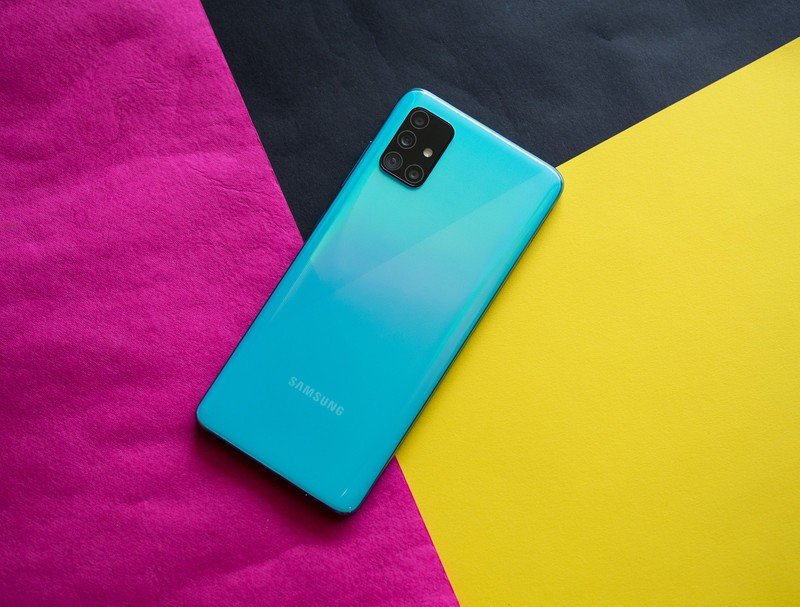
A year after its launch, the Galaxy A51 isn't a particularly great phone. The device struggles in daily use, and you can easily notice lag even in mundane tasks. The 5G version of the phone fares much better in this regard, but the 4G model just does not hold up when it comes to performance.
The reason for this is because Samsung hasn't really changed the hardware from 2019, so the Galaxy A51 is effectively running a chipset that's well over two years old at this point. With Samsung introducing 90Hz and 120Hz screens to the 2021 Galaxy A series, the Galaxy A51 also falls behind in this key area.
The phone continues to offer reliable battery life, with the 4500mAh battery lasting well over a day even with regular use. The 48MP camera is also decent enough in 2021, and while it doesn't quite hold its own next to Samsung's more recent launches, it isn't bad by any measure.
Using the Galaxy A51 alongside the A52, it's evident just how much progress Samsung has made in just one generation. The Galaxy A52 feels much nicer to hold and use — even though it is also made out of plastic — and the hardware on offer is leagues ahead, both on the 4G and 5G flavors.
The phone also has an upgraded 64MP camera, and it will get monthly security updates — a big deal in this category. Overall, if you're looking for a new phone in 2021, the Galaxy A52 or the A42 would be the ideal choice. If you've been using the Galaxy A51 for a year and are interested in upgrading, you will love what the Galaxy A52 5G has to offer.

Harish Jonnalagadda is Android Central's Senior Editor overseeing mobile coverage. In his current role, he leads the site's coverage of Chinese phone brands, networking products, and AV gear. He has been testing phones for over a decade, and has extensive experience in mobile hardware and the global semiconductor industry. Contact him on Twitter at @chunkynerd.
